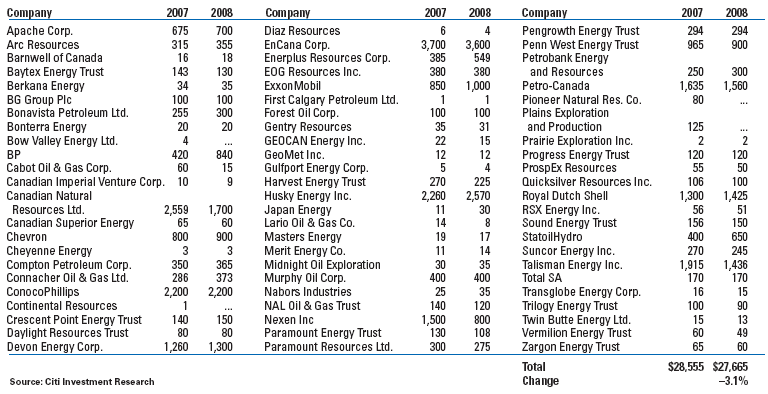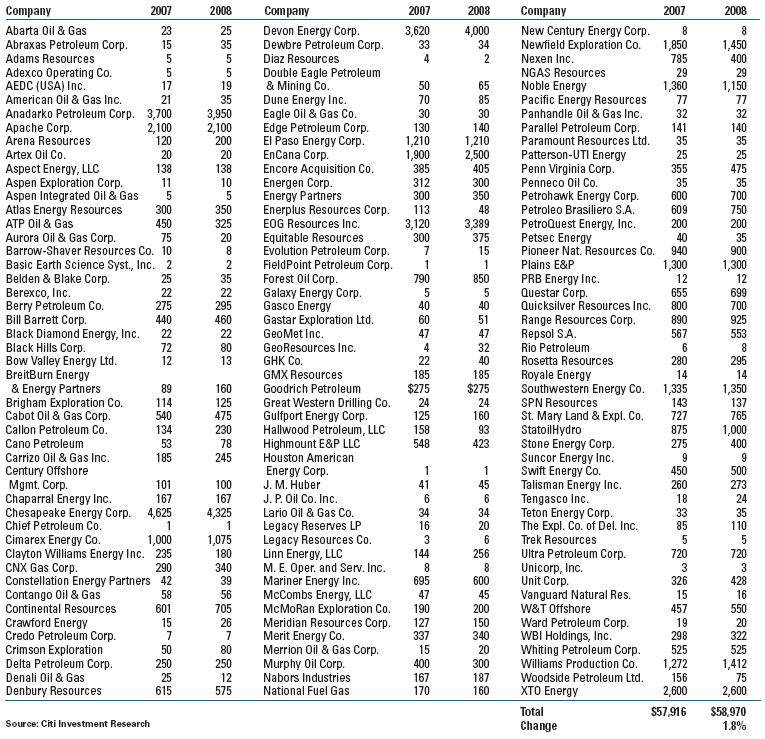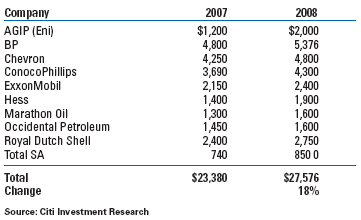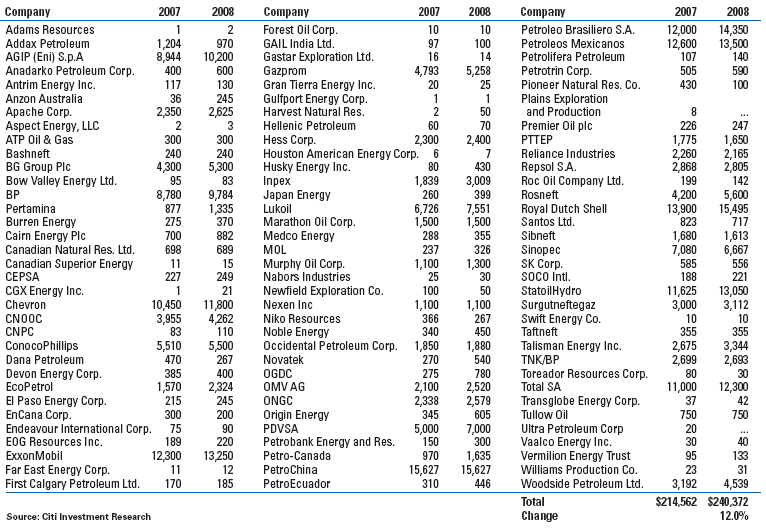Outside North America, spending should grow 12% over 2007 expenditures.
Geoff Kieburtz, W. Michael McNair, Jon Stark and Edward Muztafago, Citi Investment Research
Citi Investment Research (CIR), a division of Citigroup Global Markets Inc., published its 26th annual E&P Spending Survey on December 18, 2007. The 39-page report includes responses from 247 oil and gas companies (up from 237 in 2006) and analyzes spending for 2007 and plans for 2008, focusing on the US, Canada and regions Outside North America (ONA). The data includes 52 tables and figures plus CIR’s comments, survey highlights, the survey’s process and results, and company observations.
The authors say that the survey forecasts E&P expenditures to grow 9.3% to $354.6 billion from $324.4 billion in 2007. A pattern of overspending initial budgets continued for the eighth consecutive year with moderating cost inflation likely to support overspending in 2008. North American spending is expected to increase almost 4% to $114.2 billion. This increase will be led by the US with a 6.5% increase to $86.5 billion, but offset by a 3.1% decline in Canada to $27.7 billion. Canadian spending fell 3.4% in 2007, while US spending grew 17.9% in 2007. ONA spending will jump to $240.4 billion, a 12% increase over 2007 spending.
The authors estimate that actual 2007 spending growth will rise by 18.9% over 2006, well above the 7.0% estimate of last year’s survey. Oil and natural gas price assumptions moved higher in 2007 to about $70 for oil and $7.25 for natural gas. The rising futures strip outpaces the increase in crude oil assumptions, improving confidence for international spending. Natural gas assumptions remained relatively stable.
Operators are projecting continued, but moderating, cost inflation. US operators are projecting increased development in horizontal-drilling-intensive unconventional resources. Offshore spending growth will be limited by deepwater capacity constraints, and personnel remains a key concern.
Survey highlights. The survey reaffirms the trend of continued growth, with modest growth in the US, modest decline in Canada and solid ONA growth. Growth in US spending is expected to be 6.5% in 2008. Canada’s 2008 spending is expected to fall 3.1%. ONA 2007 growth exceeded earlier expectations at 23% and is forecast to climb 12% in 2008.
2007-2008 Canadian E&P expenditures, $ millions
Click Table to Enlarge |
 |
|
Spending diversity continues to increase. The ten largest spenders in the 2008 survey account for 44% of total spending, compared with over 51% in 2007. The respondents with the ten largest changes in planned spending account for almost 62% of the global increase. The greatest percentage of growth is expected to come from the operators with the smallest budgets, followed by the companies with the largest spending plans.
The overspending pattern continued to a seventh year in 2007. Operators have maintained a disciplined response to higher oil and gas prices, and to higher oilfield prices. This discipline reduces the risk of a severe correction and prolongs the cycle.
Higher-than-expected oil prices have been a consistent theme over the past six years. The gap between the oil price used for planning and the current strip widened into over $20/bbl, the largest on record. This strongly suggests initial 2008 plans will be overspent, if oil prices remain at present levels. Last year, most operators adapted to higher prices by raising spending plans.
2007-2008 US expenditures by independents, $ millions
Click Table to Enlarge |
 |
|
A new regional distinction has emerged. More than twice as many North American operators expect to see lower overall oilfield prices in 2008. This is driven by lower land rig and pressure pumping prices. A majority of ONA operators expect oilfield prices to be higher in 2008.
The capacity constraints underpinning the service and drilling companies’ pricing leverage shifted this past year. Capacity concerns have changed from hardware constraints to personnel. This is the first year in which half of respondents cited personnel as a concern.
Near-term and long-term oil price assumptions resumed an upward trend. In the midyear survey, the average oil price planning assumption flattened at about $57 after four years of rising steadily. In this survey, the average near-term oil price assumption climbed to almost $70. The long-term oil price assumption rose and is only a couple of dollars behind the near-term assumption.
| 2007-2008 US expenditures by major oil & gas companies, $ millions |
 |
|
Increased spending on exploration, which emerged three years ago, will pause in 2008. This is due to large projects ONA, which are moving into heavy development spending.
Last year, horizontal and directional drilling technology edged out seismic as the most frequently cited high-impact technology for the first time. This year the gap widened with over 60% of respondents listing it.
This is consistent with the near-term shift to development activity and the steady increase in unconventional resource development.
Respondents’ economic evaluation of exploration posted a modest improvement overall. Canadian operators are less positive than last year with only 37% rating economics good or excellent for oil and 36% for gas, down from over 50% last year. By contrast, US operators are positive with over 70% rating exploration economics good or excellent for oil and 75% for gas. A similar result was posted for international respondents. Nearly 80% consider oil exploration economics good or excellent and almost 60% said the same for gas.
Of the $355 billion of upstream spending planned for 2008, over 66% is for ONA projects, 24% is directed to the US and 8% is for Canada. This continues a shift away from North America.
US majors. Thirteen companies-ten majors and three independents-expect to increase spending by $150 million or more, while only nine companies expect to decrease spending by $100 million or more. Integrated majors plan to spend $4.2 billion more in the US in 2008, a 21% increase.
Initial expectations for US spending among the majors calls for an 18% increase in 2008, just over the 14% increase expected in 2007. AGIP, BP and ConocoPhillips together account for just under 50% of the spending growth with AGIP contributing the most at just under 20%.
US independents. Of the 145 independent E&P companies surveyed, nearly 47% plan to increase spending in the coming year, to $59 billion, a 1.4% increase. Those who planned to increase 2008 spending cited increased development activity in unconventional resource plays.
Pricing sensitivity remains skewed to the upside for natural gas and oil. The largest US spending increases are projected by: Encana ($600 million), Devon Energy ($380 million) and EOG Resources ($269 million). Among the largest declines are those from Newfield Exploration (-$400 million) and Nexen (-$385 million). On a percentage basis, the largest increases are from the smallest independents.
Canada. Overall spending is forecast to drop 3.1% to $27.7 billion. This follows a 3.0% decrease expected in 2007. Of the 69 companies responding, 31% plan to increase 2008 spending. A much greater decline in natural gas development spending is in the muted spending forecast, which is partly offset by an increase in oil sands development spending. Canadian producers cite poor drilling economics for the flat 2008 E&P spending. The primary drivers reported are increased service costs, weaker natural gas pricing and a higher royalty regime. Operating cash flow remains the primary concern for Canadian operators.
The decline in Canadian spending for a second year is in contrast to growth in the rest of the world. About 25% of respondents expected a recovery to emerge in 2008. Over 40% do not expect a recovery until 2009 and 33% believe it will be 2010 or beyond before Canadian activity resumes growing.
The largest spending increases are planned by: BP ($420 million), Husky Energy ($310 million) and StatoilHydro ($250 million). The largest spending decreases are planned by: Canadian Natural (-$859 million), Nexen (-$700 million) and Talisman (-$478 million).
International. The 102 ONA companies surveyed plan a 2008 spending increase of 12%, to $240.4 billion, up from $214.6 billion in 2007.
In the coming year 12 companies expect to increase spending by $1 billion or more, while eight companies expect to decrease spending by $100 million or more. Pricing sensitivity is skewed to the upside, similar to last year. The largest increases in 2008 are planned by: Petrobras ($2.3 billion), PDVSA ($2.0 billion), and Royal Dutch Shell ($1.6 billion). The largest declines are anticipated from Sinopec (-$413 million), Pioneer Natural Resources (-$330 million) and Addax Petroleum (-$234 million).
The 10 major companies are planning to increase worldwide spending by 12%, to $118.2 billion. The increase is driven largely by recent exploration successes with many companies now shifting into the development phase.
In 2007 the group’s spending exceeded their preliminary budgets by about 10%. Cost escalations in prices and finding and development costs were a main reason. The authors believe overspending of initial budgets is likely to occur again in 2008.
2007-2008 International (outside North America) E&P expenditures, $ millions
Click Table to Enlarge |
 |
|
Key observations. The latest estimate for 2007 worldwide E&P spending is an 18.9% increase, up significantly from 10.6% in the mid-year survey.
In the US, increased costs continue to push spending higher with development projects driving increasing second-half drilling activity and expenditures. In addition, natural gas pricing held firm mitigating pricing concerns. Commodity prices averaged roughly $79.60/bbl for oil and $6.65/Mcf for natural gas in the second half. The trend of stable to rising commodity prices has led to a sixth consecutive year of spending exceeding initial expectations.
- Some 60% of respondents overspent their original plans, vs. 72% in 2006. In 2007, majors were the largest overspenders of original budget plans for the second year in a row. This pattern is unusual. Long-term development plans at these companies may be taking a back seat to capturing high oil prices well above their pricing assumptions.
- For the first time since 2002, operating cash flow has become the most significant driver of planned near-term E&P spending.
- The average oil price assumption for 2008, $69.71/bbl, is up over $12.65 from 2007.
- The long-term assumption of $67.25/bbl across all respondent categories is $13.57/bbl above last year’s response. After the past couple of years of record-high commodity prices, companies have more financial flexibility. With stronger balance sheets and increased levels of cash, operators are less sensitive to commodity price changes.
- US natural gas price assumptions are stabilizing. Forward strip prices have traded sideways in a $7.00-$9.00 range, averaging close to $8.00.
- Operators view oil drilling as more attractive than natural gas drilling.
- The shift toward exploration that began in 2003 has stalled. About as many respondents plan to shift spending toward development (30%) as plan greater allocation to exploration (28%).
- After a lull in planned lease expenditures in 2007, more respondents will increase their spending on leases in 2008.
- Although at its lowest level since 2001, the percentage of respondents favoring drilling over acquiring reserves continues to be a majority.
- In the US, 70% of respondents rated oil exploration economics good to excellent, up from 57% from a year ago. In Canada, oil exploration was rated favorably by 37%. The economics of ONA exploration remain favorable.
- Finding and development costs became more manageable in 2007. Sixty-eight percent of respondents experienced higher costs this year, down significantly from 81% last year.
- Service companies and drilling contractors will face a more challenging pricing environment in 2008. Only 41% of respondents expect service pricing to increase next year, down from 44% in last year’s survey. Operators will emphasize operating efficiency and service quality in 2008.
- Horizontal/directional drilling has the top position as the technology with the highest impact on E&P spending plans. The new leader gathered 62% of respondents, up from 56% a year ago.
- Service company concerns over lack of capacity or qualified personnel are down significantly from a year ago. Sixty-seven percent of respondents cited a concern versus 84% a year ago. However, operators are increasingly challenged to find qualified people, as 50% of respondents cited personnel as a concern, up from 40% a year ago.

Note: Citi Investment Research cautions that it is not statistically accurate to compare totalestimates with those from prior years because the companies surveyed vary from year to year.
|






